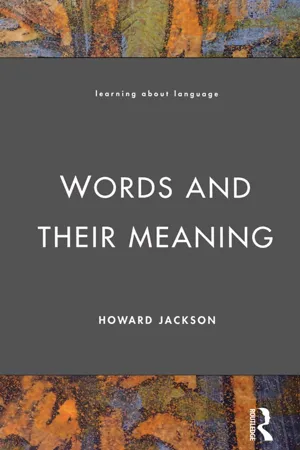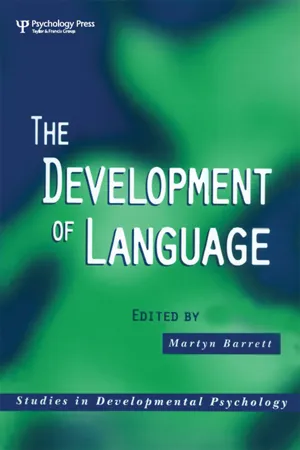Definition
A definition is a statement that explains the meaning of a word, phrase, or concept. It aims to provide clarity and understanding by outlining the essential characteristics or boundaries of the item being defined. In linguistics, definitions play a crucial role in establishing the precise meanings of words and terms within a language.
4 Key excerpts on "Definition"
- eBook - ePub
- Howard Jackson(Author)
- 2014(Publication Date)
- Routledge(Publisher)
...But CED adds a third sense which is restricted to the domain of logic. Semantics has a broader scope than just language, having a role in semiotics, the study of signs, of which linguistics (as the study of linguistic signs) is sometimes considered to be a branch. Indeed, as we shall see, there appear to be no clear boundaries to semantics, either in its narrow linguistic sense or in its broader interpretation. [3] lexicography LCED : ‘(the principles of) the editing or making of a dictionary’ CED : ‘the process or profession of writing or compiling dictionaries’ Both Definitions point to lexicography as being concerned with (the process of) making dictionaries. CED additionally indicates the use of the term to refer to the profession of those who make dictionaries, while LCED ignores this use but sees lexicography as having two parts: a theoretical part, which deals with ‘principles’; and a practical part, which deals with the editing process. Again, a conflation of the two Definitions would begin to characterise adequately the term ‘lexicography’. Now that we have some general idea of the reference of these three terms, let us explore each of them in more detail and see how they interact with each other. Lexicology Lexicology is a ‘branch of linguistics’ (LCED Definition). According to Stephen Ullmann (1962, p. 29), ‘it forms next to phonology, the second basic division of linguistic science’ (the third is syntax). Lexicology deals with ‘significant units’, i.e. ‘words and word-forming morphemes’. Consequently, there are two basic divisions of lexicology: ‘morphology’, which studies the forms of words; and ‘semantics’, which studies the meanings of words. Ullmann thus places semantics within the scope of lexicology: ‘This, then, is the place of semantics, in the strict sense of the term, within the system of linguistic disciplines’ (ibid.). Many linguists would disagree with this relatively narrow view of semantics, as we shall discuss below...
- eBook - ePub
- Martyn Barrett(Author)
- 2016(Publication Date)
- Psychology Press(Publisher)
...However, the total number of phonemes used in any one language represents only a minute fraction of the enormous number of different sounds which are actually produced through the vocal tract. Our diagram summarising the nature of language can therefore now be expanded still further (Fig. 1.3). FIG. 1.3. The nature of language (III). The level of context: Some basic distinctions So far, we have considered language at the level of meaning and at the level of sound. However, language is never used in a vacuum but always in a particular behavioural, social, or linguistic context. And this context can affect the meaning which is derived from a sentence by a listener, it can affect the choices concerning semantic content which are made by the speaker, and it can affect the lexical, grammatical, and phonetic forms which are chosen by the speaker in order to express that semantic content. The study of this complex relationship between language and the contexts in which it is used is called pragmatics (Levinson, 1983). The fact that context can influence the meaning which is derived by a listener from a sentence is clear from the following example: 9. Can you open a window? This sentence could be produced by someone in a hot, stuffy room, addressed to another person who is close to a window. In this context, the sentence would be interpreted as a request for the person to open the window. However, exactly the same sentence might be produced by a medical practitioner asking a series of questions about the range of everyday actions which a physically disabled person can or cannot perform. In this context, the sentence would be interpreted as an interrogative yes/no question, which requires a verbal response instead. The meaning which is derived from this sentence is thus not only dependent upon its constituent morphemes and its grammatical structure...
- eBook - ePub
- Istvan Kecskes, Tnde Papp(Authors)
- 2000(Publication Date)
- Psychology Press(Publisher)
...The relation between sense and word is much looser than between word meaning and word. Sense keeps changing synchronically because it is shaped by the actual thought. Word meaning changes diachronically. Sometimes it takes words decades to change their meaning. For example, the words gay or cool had different primary word meanings in the 1950s than they have now. Before discussing the thought–word relation in the bilingual–multilingual LPD we have to look at what contemporary semantic theory says about this relation. CONCEPT AND WORD IN LINGUISTIC THEORY In theoretical linguistics there has been an important change since the beginning of the 1980s because a number of linguists have come around to the view that the lexicon is the central component of a person’s internal grammar, with the syntax as subsidiary (Hudson, 1984). Chomsky claimed that parametric variation takes place in the lexicon (Chomsky, 1986, 1989). With the appearance of corpus linguistics (Sinclair, 1987, 1991), cognitive linguistics (Langacker, 1990; Nuyts, 1992), several monographs on the acquisition of the lexicon in psycholinguistics (Lehrer & Kittay, 1992; Aitchison, 1994; Gleitman & Landau, 1994) and the revival of functional linguistics (Dik, 1980; Dressler & Barbaresi, 1994) the lexicon has taken its deserved place in linguistic analysis. Following linguistic theory current L1 acquisition theory has been focusing on a lexically based framework. The lexical learning hypothesis proposes that lexical items, along with their properties, trigger the reconstruction of a child’s grammar; that is, grammars are lexically driven (see, e.g., Clahsen, 1992; Klein, 1995; Weisenborn, Goodluck & Roeper, 1992). According to the new approach the conceptual system that emerges from everyday human experience is the basis for natural-language semantics, and word meanings may not apply at all outside the relevant background assumptions since meaning and its frame are inseparable from one another (Sweetser, 1990)...
- eBook - ePub
A Guided Reader for Secondary English
Pedagogy and practice
- David Stevens(Author)
- 2012(Publication Date)
- Routledge(Publisher)
...In the face of conservative appeals for legislation to force the ‘education establishment’ to teach traditional values, including a narrow and exclusive vision of grammar and Standard English (the subjects English and history were, arguably, the most contentious and controversial in this context), linguists and teachers called for rather different approaches. Bill Mittins, for instance, entitled his influential booklet, excerpted from here, Not the Naming of Parts, in opposition to the purely analytical teaching of language, separated from its contexts of actual use. He argued instead for a genuinely creative synthesis of approaches, dispelling widely held myths concerning the nature of language while so doing. Similar critiques may be found in the work of David Allen and Katharine Perera, celebrating language diversity and its inherently fascinating qualities. More recently, Debra Myhill reminds us powerfully that the debates are still very much ‘live’; indeed their relevance to current English classrooms is today even more urgent than it was two decades ago. Extract 1.1 Language is the creation and communication of meaning. Through language we remember the past, experience the present, and predict and plan the future. We experience the lives of others through language and give them accounts of our own. Through literature we extend these encounters so that we learn, and convey to others, lives, events and feelings beyond the limits of our daily world. Our own use of language is the nearest representation of ourselves that we commonly have. By their reaction to our words, others can hurt or heal us, foster or diminish us. Language gives us the ability to acquire knowledge, solve problems and give meaning to our existence. It forms an essential part of the process by which societies are formed and perpetuated. Individuals learn meanings from social situations in which they take part. Ultimately they pass on these meanings to others...



